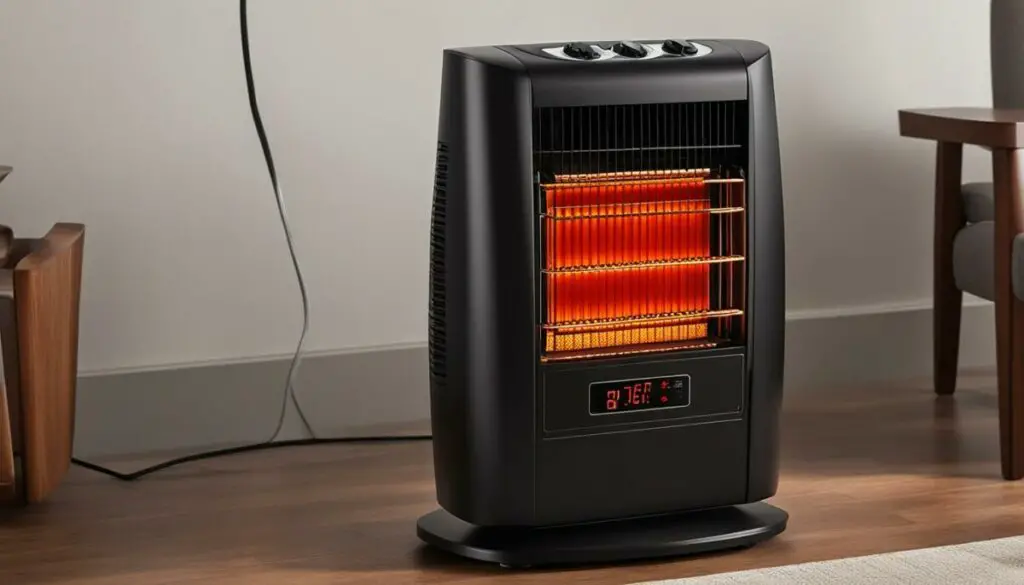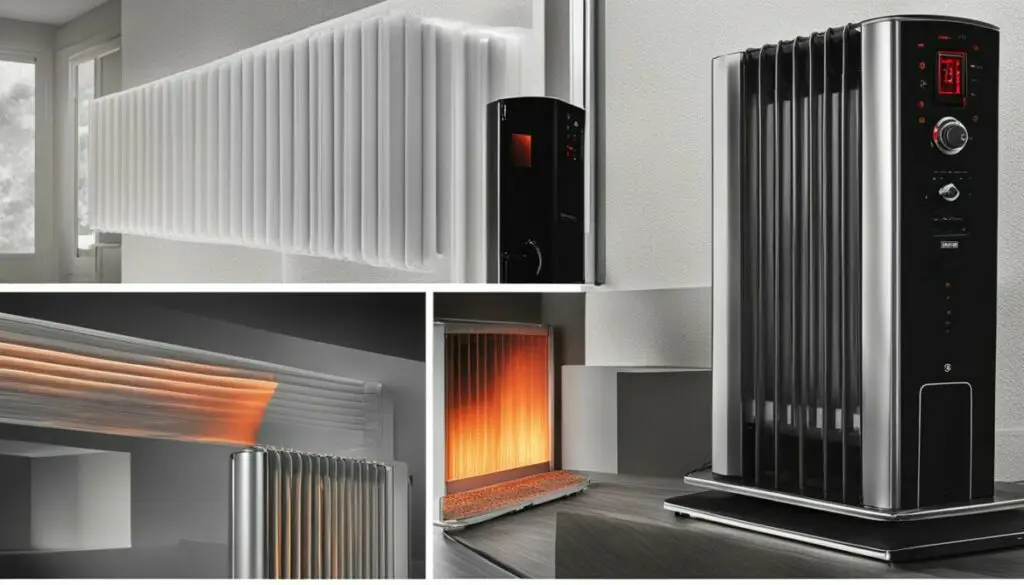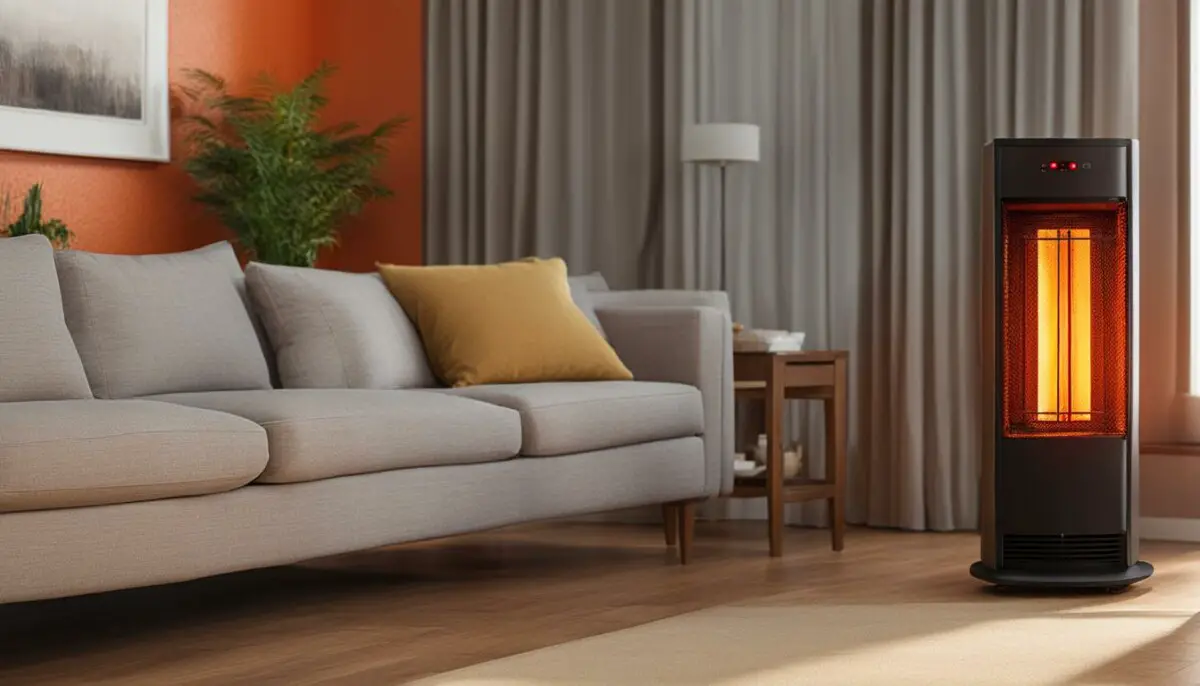Last Updated on 4 months by Francis
Are infrared space heaters really convection heaters? Let’s uncover the truth about infrared heating and how it differs from convection heating. While they both serve the purpose of keeping us warm, there are fundamental differences in how they operate and the benefits they offer.
Contents
Key Takeaways:
- Infrared heaters use infrared radiation to directly heat objects, while convection heaters indirectly warm the air in a space.
- Infrared heaters are more effective in outdoor areas as they heat objects instead of the air.
- Infrared heaters offer better energy efficiency and can provide more comfortable temperatures with lower thermostat settings.
- Considerations for choosing an infrared space heater include the IP rating, high-quality materials, and design options.
- While infrared heaters have their advantages, heat pumps remain a more sustainable option for overall heating needs.
How do Infrared Space Heaters Work?

Infrared space heaters operate using a fascinating technology that harnesses the power of infrared heat. These heaters emit infrared radiation, which is then absorbed by objects in its path. When this radiation is absorbed, it causes the molecules in the objects to vibrate, generating heat in the process. This direct method of heating allows infrared space heaters to efficiently warm up a targeted area.
Infrared heat technology involves the use of an electric charge passing through a specialized material, such as a quartz tube or a ceramic element. Once the material is charged, it emits infrared radiation that heats up the surrounding objects rather than heating the air itself. This makes infrared heaters extremely effective, as they provide warmth directly to people and objects in the room rather than wasting energy by heating the entire space.
The unique ability of infrared space heaters to emit infrared radiation makes them suitable for a variety of heating applications. This technology is commonly found in electric convection radiators, halogen heaters, and other types of infrared heaters.
Key Points:
- Infrared space heaters work by emitting infrared radiation that is absorbed by objects, causing them to increase in heat.
- These heaters use an electric charge passing through specialized materials to generate infrared heat.
- Infrared heaters provide efficient and targeted heating by directly warming up objects and people in the room.
By understanding the science behind how infrared space heaters work, we can fully appreciate their effectiveness and efficiency in providing warmth. In the next section, we will explore the various benefits of infrared space heaters and why they are an excellent heating solution for many homes and spaces.
Benefits of Infrared Space Heaters

Infrared space heaters offer numerous benefits that make them a popular choice for heating solutions. Let’s explore some of the key advantages:
- Energy Efficiency: One of the standout benefits of infrared space heaters is their superior energy efficiency. Unlike conventional forced-air systems that heat the entire space, infrared heaters emit focused heat that directly warms the objects in the room. This targeted heating reduces heat loss and ensures efficient energy utilization.
- Comfortable Temperatures: Infrared radiant heaters provide a more comfortable indoor environment by creating consistent warmth at lower thermostat settings. The heat is evenly distributed, eliminating cold spots and drafts that are common with traditional heating methods. This allows you to enjoy cozy temperatures without having to constantly adjust the thermostat.
- Silent Operation: Unlike some heating systems that rely on fans or other moving parts, infrared space heaters operate silently. This is particularly beneficial in bedrooms, nurseries, or living spaces where noise can be disruptive. With an infrared heater, you can enjoy a peaceful and calm ambiance while staying warm.
- Durable Construction: Infrared space heaters are designed to withstand various environmental conditions, making them suitable for both indoor and outdoor use. High-quality materials like stainless steel are often used in their construction, ensuring durability and longevity. Their sturdy build ensures that they can withstand the test of time, providing reliable heating for years to come.
Overall, infrared space heaters offer a range of advantages, including energy efficiency, comfortable temperatures, silent operation, and durability. These benefits make them an attractive option for both residential and commercial heating needs.
| Benefits of Infrared Space Heaters | Advantages |
|---|---|
| Energy Efficiency | Reduced heat loss, efficient energy utilization |
| Comfortable Temperatures | Consistent warmth, no cold spots or drafts |
| Silent Operation | Noisy-free heating experience |
| Durable Construction | Designed to withstand various environmental conditions |
To further illustrate the advantages of infrared space heaters, take a look at the following quote:
“I’ve been using an infrared space heater in my bedroom for the past year, and it’s been a game-changer. Not only does it provide cozy warmth on cold nights, but it operates silently, allowing me to sleep soundly without any disturbances. I also appreciate the energy efficiency, as it has helped lower my heating bills. Overall, I highly recommend infrared heaters for their efficiency, comfort, and durability.” – Sarah, homeowner
With their energy efficiency, comfort-enhancing features, silent operation, and durable construction, infrared space heaters prove to be a practical heating solution for various settings.
Differences Between Infrared and Convection Heaters

When it comes to heating methods, there are clear distinctions between infrared and convection heaters. Infrared heaters utilize infrared radiation to directly heat objects in a space, while convection heaters rely on heating the air to indirectly warm the surroundings.
The difference in heating methods leads to varying levels of effectiveness and energy efficiency between infrared and convection heaters.
Infrared heaters are particularly effective for outdoor heating because they directly heat objects, such as people, furniture, or floors, instead of wasting energy on heating the air. This targeted warmth allows for efficient and effective heating in outdoor spaces.
On the other hand, convection heaters are more commonly used indoors, where distributing warm air throughout the room is the primary goal. These heaters warm the air by heating a heating element, such as a resistor, and then circulating the warm air using fans or natural convection.
Here’s a summary of the key differences between infrared and convection heaters:
- Infrared heaters directly heat objects, while convection heaters heat the air.
- Infrared heaters are more effective for outdoor heating, while convection heaters are commonly used indoors.
- Infrared heaters provide targeted warmth, while convection heaters distribute warmth throughout the room.
- Infrared heaters offer better energy efficiency by avoiding heat loss through air circulation.
Ultimately, the choice between infrared and convection heaters depends on the specific heating needs and environment. Infrared heaters excel in providing efficient outdoor heating and targeted warmth, while convection heaters are better suited for indoor spaces where distributing warm air evenly is important.
Here’s what some experts have to say:
“Infrared heaters are a game-changer for outdoor spaces. Their ability to directly heat objects instead of wasting energy on heating the air makes them highly efficient in providing warmth in open environments.”
“Convection heaters shine indoors, as they are designed to circulate warm air throughout the room. Their ability to evenly distribute heat is crucial for creating a comfortable indoor environment.”
Effectiveness of Convection Heaters in Outdoor Spaces

When it comes to heating outdoor spaces, convection heaters may not be the most effective option. This is primarily due to their heating method, which focuses on warming the air in a closed space. Unfortunately, this heated air quickly dissipates into the surrounding environment, resulting in ineffective heating in outdoor areas.
In comparison to infrared heaters, which heat objects directly, convection heaters struggle to provide sufficient warmth outdoors. The inefficient nature of convection heaters in outdoor environments makes them less suitable for effectively heating these spaces.
To illustrate the limited effectiveness of convection heaters in outdoor spaces, consider the following table:
| Heating Method | Effectiveness |
|---|---|
| Convection Heating | Ineffective in outdoor spaces |
| Infrared Heating | More effective for outdoor heating |
As shown in the table above, convection heaters lack the ability to provide the necessary warmth in outdoor areas. In contrast, infrared heaters excel in outdoor heating by directly heating objects, such as people, furniture, or surfaces, resulting in a more efficient and targeted warming effect.
Therefore, if you’re looking to effectively heat your outdoor space, it’s advisable to consider alternatives to convection heaters, such as infrared heaters that can provide the desired level of warmth and comfort.
With a clear understanding of the limitations of convection heaters in outdoor areas, it’s important to explore other options that can meet your heating needs more effectively.
Considerations for Infrared Space Heaters

When choosing an infrared space heater, there are several important considerations to keep in mind. These factors will ensure that you select the right heater for your needs, whether it’s for indoor or outdoor use.
1. Ingress Protection (IP) Rating
The IP rating indicates the level of protection that the heater has against solids and liquids. It is particularly crucial for outdoor heaters that will be exposed to various weather elements. It is recommended to choose a heater with an IP rating of at least IPX4 for outdoor use.
2. High-Quality Materials and Construction
The durability and longevity of an infrared space heater depend on the quality of its materials and construction. Opt for heaters that are made with high-quality materials, such as stainless steel, which can withstand outdoor conditions and resist corrosion.
3. Innovative Designs
Different infrared space heaters come with innovative designs that not only enhance their performance but also complement various outdoor spaces. For example, Platinum Heaters feature an innovative ceramic glass screen that not only provides efficient heat distribution but also adds an aesthetic touch to your space. Additionally, Tungsten Heaters come with a bold metal grill design that not only ensures durability but also adds a contemporary look to your outdoor area.
| Brand | Design |
|---|---|
| Platinum Heaters | Ceramic glass screen |
| Tungsten Heaters | Bold metal grill |
These innovative designs not only provide efficient heating but also serve as stylish additions to your outdoor space.
In summary, when choosing an infrared space heater, consider factors such as the IP rating, high-quality materials, and innovative designs. Investing in a well-designed and durable heater will ensure optimal performance and enhance the overall aesthetic of your outdoor area.
Potential Issues with Infrared Heating
Infrared heating offers many benefits, but it’s important to be aware of potential issues that may arise. Understanding these challenges can help you make an informed decision when considering infrared heating for your space.
Uneven Heating and Heat Shadows
One potential issue with infrared heating is the possibility of uneven heating and heat shadows. Infrared heaters emit infrared radiation that directly heats objects in its path. However, if furniture or other objects obstruct the path of the infrared radiation, those areas may not receive adequate heat.
“Infrared heating is great, but it’s essential to ensure that there are no obstacles blocking the infrared radiation. Otherwise, you may end up with uneven heating in your space.”
This issue can be addressed by proper placement and installation of the infrared heaters. By positioning the heaters strategically, you can ensure better coverage and minimize the occurrence of heat shadows.
Dampness and Mold Growth
Another potential issue with infrared heating is the reduced overall heat demand in a building. Infrared heaters provide targeted heat to objects and people, rather than heating the entire air in a space. As a result, the air temperature in the room may be lower compared to traditional heating methods.
This reduced heat demand can lead to increased dampness and moisture retention in the air, which can create a conducive environment for mold growth. It is important to maintain proper ventilation and humidity control in spaces with infrared heating to mitigate the risk of mold growth.
No Hot Water Supply
It’s important to note that infrared heating systems do not provide hot water. In some homes, hot water supply is a significant demand, especially for activities such as showering, laundry, and dishwashing.
If you rely on a separate hot water system, make sure to account for this when considering infrared heating. It may require a separate water heating solution to meet your household’s hot water needs.
While infrared heating offers numerous advantages, it is essential to understand and address these potential issues for a successful implementation. By considering these factors, you can make an informed decision and maximize the benefits of infrared heating in your space.
Comparison with Heat Pumps
When it comes to heating options, heat pumps have gained popularity due to their efficiency and cost-effectiveness, outperforming resistive heating methods like infrared and convection heaters. Heat pumps offer a higher heat output for each unit of electricity consumed, making them an energy-efficient choice. Additionally, heat pumps are more environmentally friendly as they reduce the carbon intensity of heat.
Infrared heating may be suitable for specific scenarios, such as inefficient spaces or extremely efficient buildings. These heaters emit infrared radiation, providing targeted warmth and can be advantageous in outdoor settings. However, in terms of overall heating and hot water requirements, heat pumps are the preferred choice due to their ability to efficiently provide both.
Let’s take a closer look at the advantages of heat pumps over infrared and convection heaters:
| Comparison Factors | Heat Pumps | Infrared Heaters | Convection Heaters |
|---|---|---|---|
| Heating Efficiency | High, providing a higher heat output for each unit of electricity used. | Varies, depending on the specific model and usage. | Varies, depending on the specific model and usage. |
| Operating Cost | Lower, as heat pumps make the most of existing heat in the air or ground. | Varies, depending on the specific model and usage. | Varies, depending on the specific model and usage. |
| Carbon Footprint | Reduced, as heat pumps use electricity more efficiently and reduce the reliance on fossil fuels. | Varies, depending on the source of electricity used. | Varies, depending on the source of electricity used. |
| Heating and Hot Water | Capable of providing both heating and hot water efficiently. | Primarily designed for heating purposes, does not provide hot water. | Primarily designed for heating purposes, does not provide hot water. |
| Flexibility | Can efficiently heat or cool spaces, offering versatility. | Primarily designed for heating purposes only. | Primarily designed for heating purposes only. |
“Heat pumps provide a more efficient and cost-effective heating solution compared to infrared and convection heaters. Their ability to provide both heating and hot water makes them a versatile option for residential and commercial spaces. Moreover, heat pumps contribute to a lower carbon footprint, aligning with sustainable energy goals.”
While infrared heaters have their advantages, such as targeted warmth and suitability for specific situations, heat pumps remain the preferred choice for overall heating needs. They offer better efficiency, cost savings, and the ability to provide hot water, making them a practical and sustainable solution.
Conclusion
In conclusion, infrared space heaters offer distinct advantages over convection heaters. Unlike convection heaters, infrared heaters operate by emitting infrared radiation, which enables more effective outdoor heating, improved energy efficiency, and targeted warmth. The direct heating method of infrared heaters makes them ideal for heating outdoor areas, as they heat objects rather than the air. This not only results in more efficient heating but also provides more comfortable temperatures with lower thermostat settings.
However, it is important to note that infrared heating may have some limitations. The direct nature of infrared radiation can lead to uneven heating and shadowing if furniture or objects obstruct the radiation’s path. Additionally, the reduced overall heat demand of a building with infrared heating may cause increased dampness and potential mold growth. Furthermore, it is crucial to consider specific requirements and factors when choosing between infrared and convection heating methods, as each has its own set of advantages and disadvantages.
While infrared space heaters have their benefits, it is worth considering heat pumps as a more sustainable and efficient option for overall heating needs. Heat pumps offer a higher heat output for each unit of electricity used and are more carbon-friendly, reducing the carbon intensity of heat. Although infrared heating may be suitable for particular situations like inefficient spaces or extremely efficient buildings, heat pumps provide a more favorable solution for heating and hot water requirements.
FAQ
Are infrared space heaters really convection heaters?
No, infrared space heaters are not convection heaters. While convection heaters indirectly warm the air in a space, infrared heaters emit infrared radiation that directly heats objects.
How do infrared space heaters work?
Infrared space heaters work by emitting infrared radiation that is absorbed by objects in its path, causing the molecules in the objects to vibrate and increase in heat. This direct heating method allows for efficient and targeted heating.
What are the benefits of infrared space heaters?
Some benefits of infrared space heaters include greater energy efficiency, more comfortable temperatures with lower thermostat settings, and silent operation due to the absence of moving parts like fans. They are also designed to withstand various environmental conditions, with high-quality materials used for improved durability.
What are the differences between infrared and convection heaters?
The main difference between infrared and convection heaters lies in their heating methods. Infrared heaters directly heat objects using infrared radiation, while convection heaters heat the air in a space, indirectly warming the surroundings.
How effective are convection heaters in outdoor spaces?
Convection heaters are not effective in outdoor spaces as they primarily heat the air, which quickly escapes into the environment. This results in ineffective heating in outdoor areas.
What considerations should be made when choosing infrared space heaters?
When choosing infrared space heaters, it is important to consider factors such as the ingress protection (IP) rating for outdoor heaters and the use of high-quality materials like stainless steel for durability. Different designs are also available to complement various outdoor spaces.
Are there any potential issues with infrared heating?
Potential issues with infrared heating include heat shadows and uneven heating if objects obstruct the path of the infrared radiation. Additionally, reduced overall heat demand can lead to increased dampness and mold growth. It is important to note that infrared heating does not provide hot water.
How do infrared heaters compare to heat pumps?
Heat pumps offer a more efficient and cost-effective heating option compared to infrared heaters and convection heaters. They provide higher heat output per unit of electricity used and are more carbon-friendly, reducing the carbon intensity of heat.
What is the conclusion regarding infrared vs. convection heaters?
In conclusion, infrared space heaters are not convection heaters but operate through the emission of infrared radiation. They offer several advantages over convection heaters, including more effective outdoor heating, energy efficiency, and targeted warmth. However, heat pumps remain a more viable and sustainable option for overall heating needs.


.jpg)





